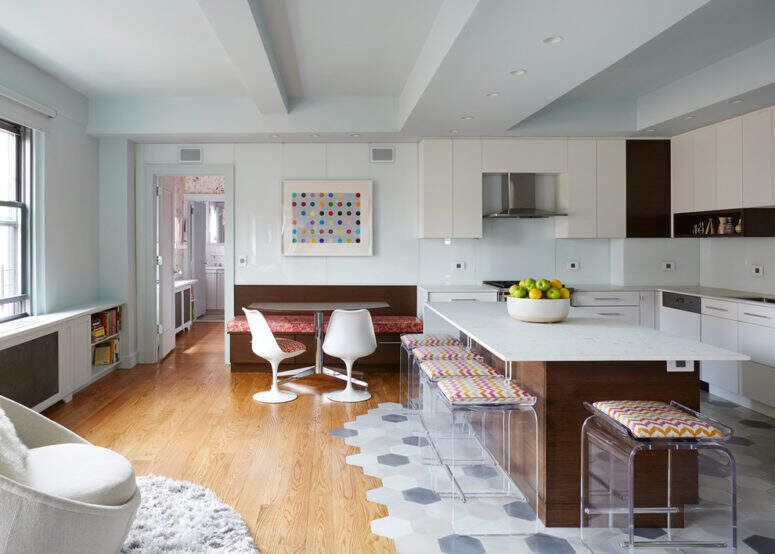Do you own a kitchen with lovely tiles and classic warm wood flooring? You’re not alone if you think the switch from both is quite difficult. Making a seamless and sleek transition using these trendy materials cannot be challenging. Don’t be afraid; this article includes creative and practical kitchen tile-to-wood floor transition options.
Whichever style you prefer, whether it is a cool and modern look, a touch of classic class, or a personal statement piece, we have you covered. From the limits and overlays created by designers to the clever grout techniques and selections of natural materials, let’s look at a wide variety of amazing options that will transform that gap into one of your kitchen design’s main features.
11 Kitchen Tiles to Wood Floor Transition Ideas
Let’s start with some cool kitchen tile to wood floor transition ideas. From flush borders to decorative borders we cover everything. We assist in this shine with herringbone patterns and transition strips. Hence, Stick to the following cool transition tips below.
1. Border Transition
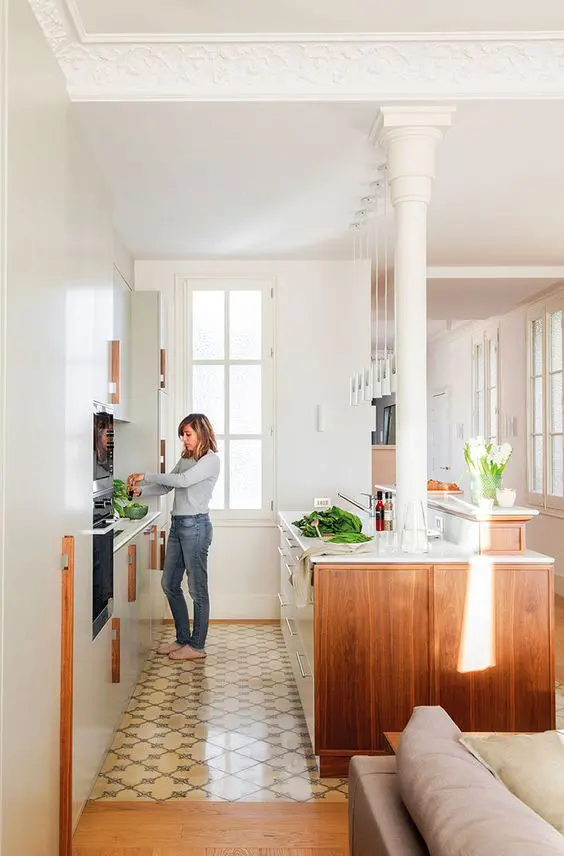
The Border Transition is where wood and tile meet, but instead of making the line with a pencil, it will have cool colors or shapes. You can color outside the lines as well.
Pick out some vintage or traditional tiles or wood pieces and put them along the edge of the transition. You can use irregular sizes, colors, or even materials for your tiles that stand out from your primary tile area. An alternative is to make it more creative by adding reclaimed wood for borders that will add warmth, texture, and a bit of eco-friendliness to your kitchen. Edge the tile and the wood floor with a small border of pebble tiles to mimic the organic ambiance.
2. Diagonal Transition
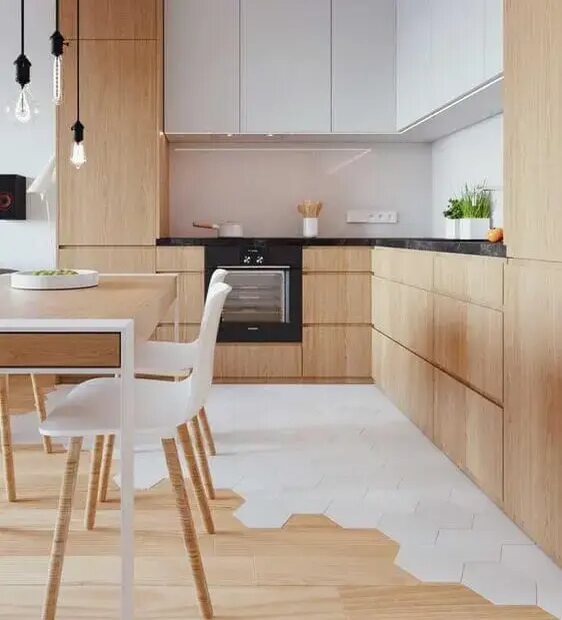
Diagonal lines create an illusion of movement, making your kitchen appear more open. Apply Angle Tile with Inlay by arranging the main tile in a square pattern. To do this, draw a diagonal stripe using various tiles around the transition zones.
Substituting chevron Tile Patterns for straight diagonals may be appropriate. With the thoughtful application of a diagonal transitional layout, your kitchen can feature a beautiful focal point that enhances the design, makes it classier, and adds elegance to your space.
3. Herringbone Transition
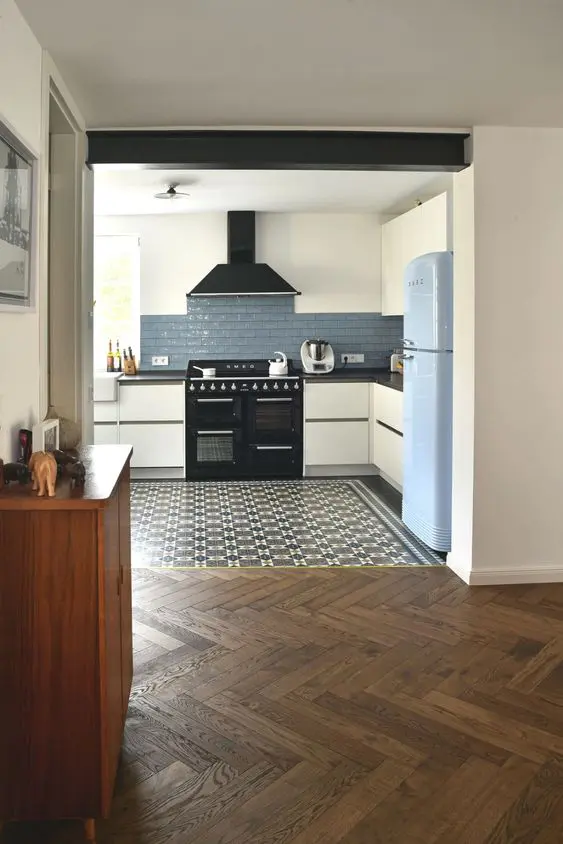
The herringbone pattern gives a classic and stylish look to your kitchen. The zig-zag pattern further enhances the transitional interest point. Start by creating a section of diagonally laid herringbone tiles where the tile meets the wooden floor.
Keep your primary field tile square while you proceed to the last few rows in the herringbone pattern. Make sure the tile sizes are suitable for the scale of your kitchen and the width of your wooden floor planks. Try a darker grout to complement the Herringbone pattern.
4. Flush Transition
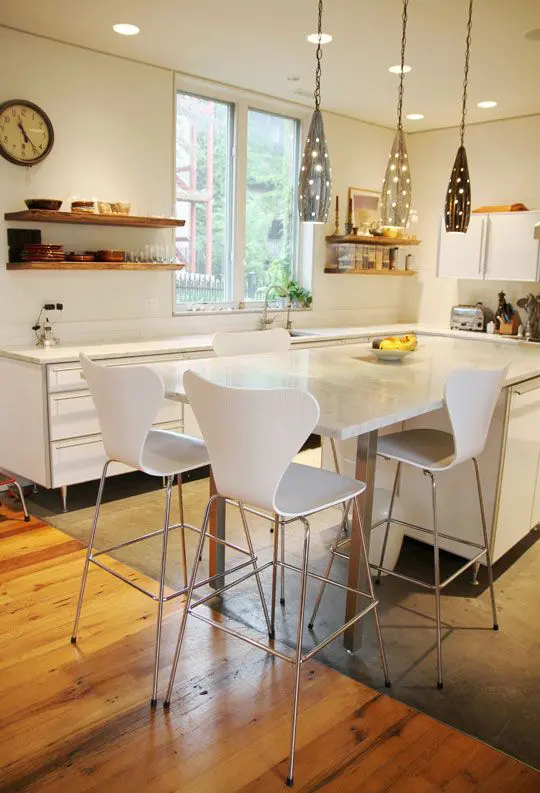
Generally, Flush Transition floor tile and wood styles are designed on one level. It is like sliding on the floor, moving from one room to another.
Therefore, the question is: How can it be done? Make sure both the tile and the wood flooring are installed at the same level. Overall you can use a 1/2-inch cement board as the substrate and a 1/4-inch cement board overlaid with a 1/8-inch uncoupling membrane.
5. Decorative Transition
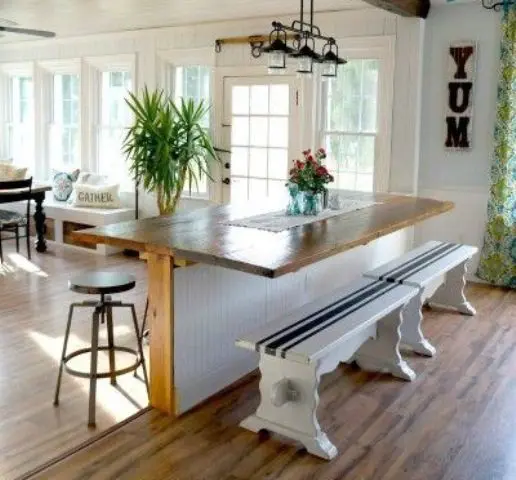
Decorative Transition transforms into fancy floors of your kitchen with some fantastic patterns and designs. Now choose, for example, Wood Inlay, Curved or Medallion design, and splice some goodies where the two floors meet; it will be great! In mixing and matching materials, thin wood borders around the tile perimeter are a must, while switching from a subway tile pattern to the herringbone towards the wood floor is also required.
Furthermore, color can be your friend at the time of installation. For example, you can design a mosaic tile border or a grout line between the tiles and the wood floor.
6. Medallion Transition
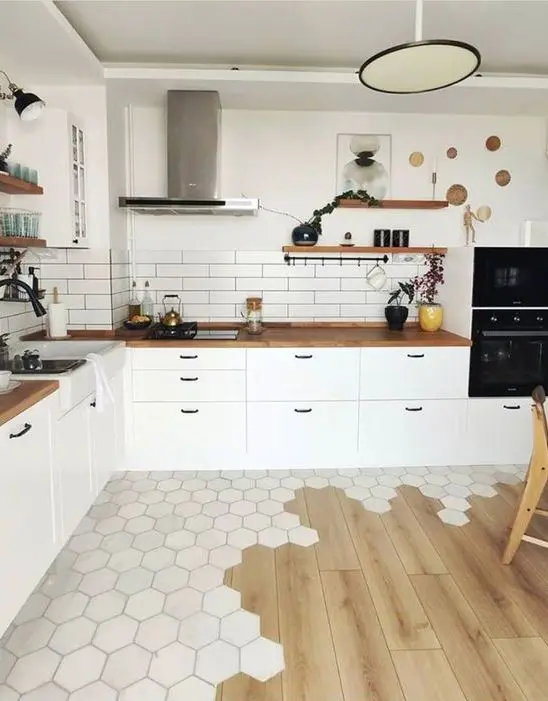
This design begins with the tiling of a medallion in the middle of the transition zone. Off-center the tiles to build a more dynamic visual flow. The foremost aspect is picking the suitable design that goes well with the existing tile or wood floor.
However, you can choose a Mosaic Tile Medallion, Stone or Metal Medallion, or a medallion matched to a Wood Species. Remember that a beautiful medallion can be a centerpiece of the kitchen, adding a touch of elegance and character.
7. Transition Strip
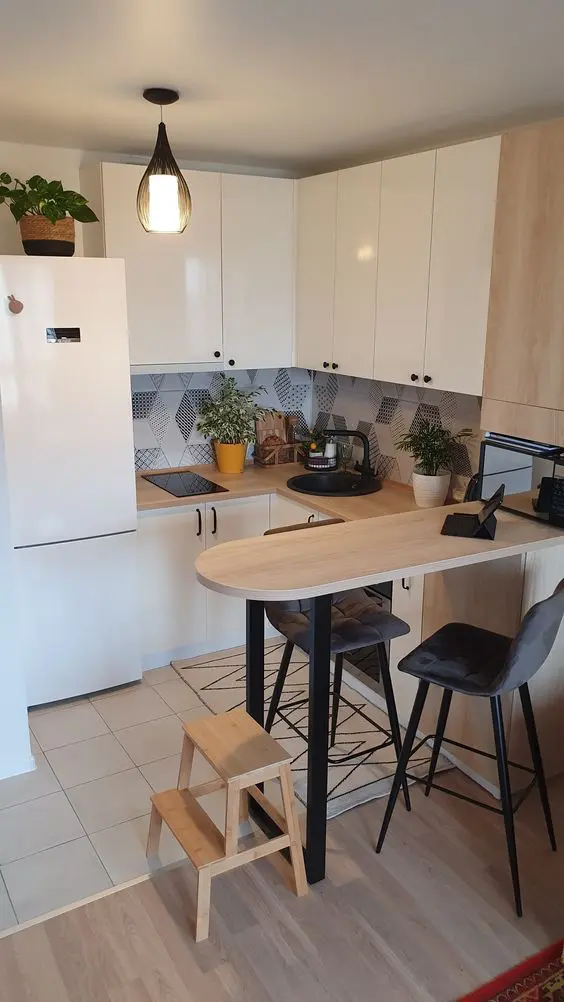
The transition strips are a convenient crossover between the wood floor and kitchen tile. The design minimizes the risk of tripping, which usually happens because of the uneven space between them. Similarly, it also seals the tile edges from ordinary wear and tear.
Transition strips can be of different shapes, sizes, materials, and patterns, which will go hand in hand with existing floor types. Overall you can select metal for resilience, wood for a warm and natural appearance, or rubber strips for flexibility and sound damping.
8. Threshold Transition

The transition strips are critical if there is a big difference between your tile and wood floor. They can stand up to heavy traffic in your kitchen due to the sturdy materials they are made of. The thresholds simultaneously cover the expansion gap and guard the side edges of the floor.
You can customize the Thresholds transition to match the styling options you need. A Flat Threshold is a simple and functional option for minor height differences, a Ramp Threshold for more considerable height variations, or decorative ones to create an appealing appearance.
9. Inlay Transition
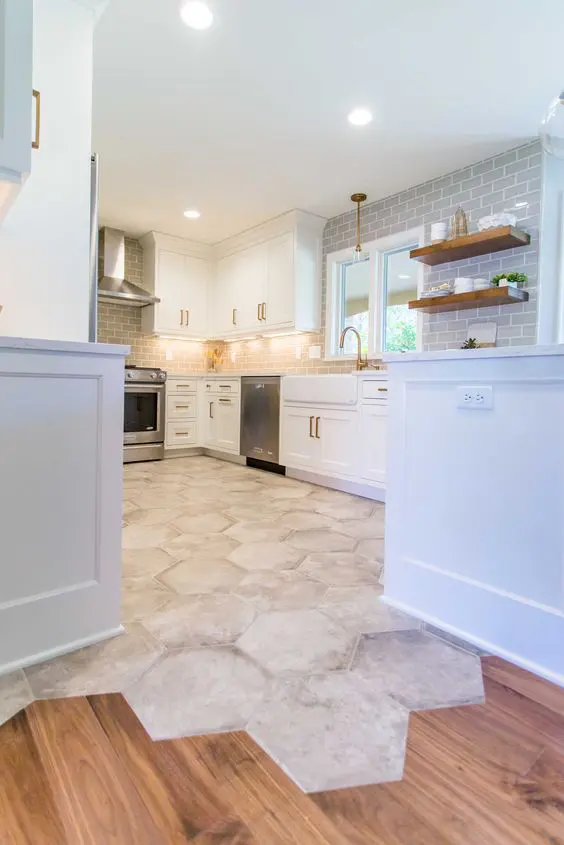
Inlay transitions insert a decorative element and take your kitchen to the next level. They efficiently address the expansion gap between the tile and the wood floor. Inlays strategically placed also mask subtle unevenness on the floor.
For this transition, pick up some geometric shapes, including squares, rectangles, chevrons, and mosaic artwork. At the same time, the inlay transition, width, and grout colors should match the kitchen floor that is already there.
10. Grouted Transition
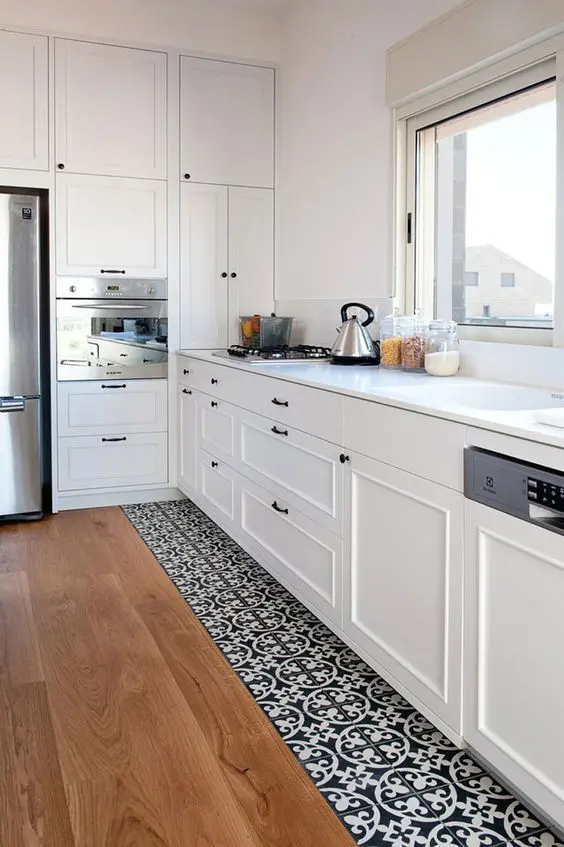
Grouted transitions provide a precise option to fill the gap between the kitchen tiles and the wood flooring at a relatively cheaper cost. It is an affordable and readily available material and, thus, is a perfect choice for the transition. The proper seal on the grout can provide some water resistance, keeping the subfloor from possible moisture spills. You can choose from 3 types of transitions: design.
The simplest one is the straight grout line, characterized by the most basic option for clean and defined separation, and soldier course grout lines for the cohesive look of the transition area. Then there is the Decorative Grout Inlay, a simple geometric pattern within the transition area.
11. Natural Transition
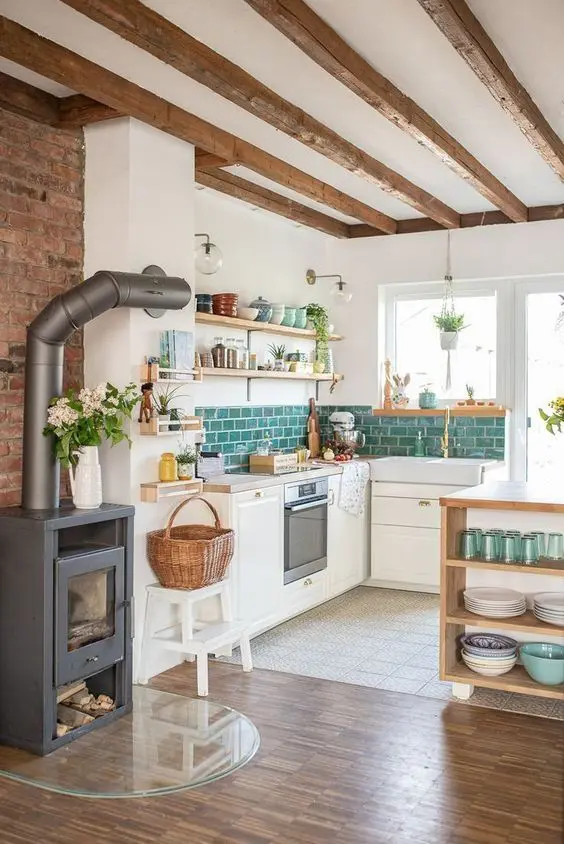
This transition emphasizes the importance of seamlessly connecting the two resources. Typical items for the design are Wood Look Tile, Cork Flooring, and Natural Stone Tiles. Gradual change design is becoming very popular in this folding transition. Large format tiles will be placed in the main tile field area, and smaller tiles will be placed near the wood floor.
It is a point where a smooth transition is created. Moreover, there are also available Matching Grout and Flush Transition options. For a realistic effect, lessen the light intensity and employ neutral colors and different textures of the separation.
Also Read: Coordinating Wood Floor With Wood Cabinets Perfectly
FAQs
What Tile Looks Good Next to Hardwood Floors?
Many centuries-old classics, like porcelain and ceramic, look great next to hardwood floors. They will add elegance and make the space look cohesive and stylish.”
Should Tile and Hardwood Go in the Same Direction?
Frankly, it depends on you. This makes connecting them possible while interchanging directions, which provides visual interest. No matter what, ensure it will merge with your space and match your style.
What Are Some Popular Tile-to-wood Transition Ideas?
There are plenty! The choices are vast, from simple flush transitions to decorative borders and herringbone patterns to transition strips. Decide the one that looks good to your taste and makes your kitchen look lovely.
Do You Need a Transition Strip Between Hardwood and Tile?
It depends! If there’s a height difference, it’s a yes. It gives the customers a smooth journey. However, it’s optional if they’re playing at the same level. Take your room and taste into account before purchasing furniture.
Do You Grout Between Tile and Wood Floors?
Yes, if all you want is a smooth makeup. Grouting helps to fill gaps and adds stability. However, if a smooth transition is your choice, then skip it. Consider your taste and ease of caring for the plant when determining your best option.
Conclusion
That’s the guide about kitchen tile to wood floor transition ideas. We hope you get a clear answer related to the topic. So, various kitchen tile-to-wood floor transition ideas are available. You can choose flush transition, directional, diagonal, or decorative; selecting the right size and materials is essential. Overall always find items that complement your existing floor design.
Also Read: 5 Methods to Transition Between Two Different Wood Floors

